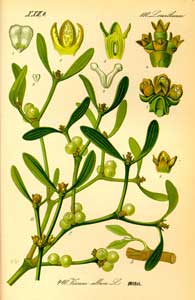What is a mistletoe ?
The name mistletoe strictly applies to Viscum album L., the plant famous in European and Asian folklore. It ranges from Europe through the Middle East and the Himalayas to south-eastern Siberia and Japan. More generally, however, the term mistletoe refers to perennial flowering plants, usually woody and shrubby or vine-like, which grow as parasites attached to the branches of trees and shrubs. When this broader definition is applied, we find that there are about 1400 species of mistletoes, represented in four families of the order Santalales. The family Loranthaceae is the largest, and all but three of its almost 1000 species exhibit the mistletoe habit. All 400 species of Viscaceae are mistletoes. All members of the small South American family Myzodendraceae are mistletoes, and finally there are a few mistletoes among the many species of Santalaceae. Mistletoe species in Loranthaceae, Viscaceae and Santalaceae all occur in Australia. Some recent authors have suggested that the Viscaceae should be included within a more broadly circumscribed family Santalaceae, but for convenience we will treat them separately on this website.
The essential feature of the mistletoe habit is that the root system is highly modified to form one or more haustoria, which function both for attachment to the host and for nutrient absorption. The haustorium penetrates the bark of the host, probably by enzymatic breakdown, and grows to the host’s cambial layer where new xylem (water-conducting) cells are generated. The haustorium’s secretions usually cause the host’s xylem cells to proliferate, and to form a continuous connection with the xylem of the parasite’s haustorium. The mistletoe thus becomes a parasite utilizing the host’s water supply with its dissolved nutrients. The vast majority of mistletoe species have green leaves, and carry out photosynthesis normally, so they are actually partial parasites, taking up only water and mineral salts from the host. However a small percentage of mistletoes appear also to utilize the sugars and other organic nutrients transported in the host’s phloem system.
The growth of the mistletoe haustorium often restricts nutrient flow further along the host branch, and the distal part may die, leaving the mistletoe in a terminal position on the branch.
![An Australian Government Initiative [logo]](/images/austgovt_brown_90px.gif)


